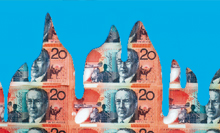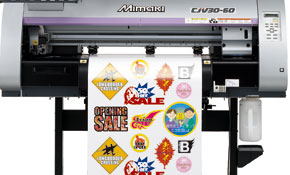
Printers can get a bit blue when pricing up major overheads such as wages and paper. But while it’s unlikely that the cost of litho inks will make the difference between staying in the black or sinking into the red, they’re not cheap.
There is no ink or consumables price indexing tracked by Printing Industries, but it is generally thought that the buoyant economy and strong Australian dollar has shielded printers from the worst excesses of northern hemisphere price hikes. But the impact has not been uniform across the industry.
Heidelberg’s consumables manager, Kevin Birch, has seen ink pricing from manufacturers increase by 15% over the past 24 months, much of it driven by increases in resin prices, “but we have seen in the market that printers are getting reductions of 15%”. This anomaly has left manufacturers straining to span the growing chasm between rising costs and downward pressure on ink prices.
Birch says a number of variables will determine what sort of deal a printer can snare. End user pricing is subject to various factors, mainly volume and total spend of the customer with that vendor. “Quality is also is a big factor. If the customer wants to print to ISO standards, there is a price for manufacturing an ink to meet these stan-dards. There will also be someone offering a cheaper ink but how that ink performs on the press and throughout the prod-uction process is often a false economy.”
He says making ink go further depends on quality choices. Premium inks, such as Heidelberg’s Saphira XT range, have strong pigmentation, which helps assure correct densities, according to Birch. Higher-end inks also dry quicker, minimise scuffing, reduce repeat work and ensure timely delivery to the bindery.
It is important to work with a supplier that can offer back-up, so downtime is reduced. Having a single-supplier contract means one supplier takes responsibility for resolving problems.
Brian Doyle, chief executive of Brisbane-based Platypus Graphics, says careful positioning has enabled the 25-year-old operation to keep the lid on billowing consumables costs.
The company produces a wide array of digital, litho and packaging products – and hence is a major ink user.
Doyle says over the past two years, he has seen a trend in prices from his primary ink supplier (who he won’t name). In fact, the vendor has dropped its prices by 50 cents per kilo over the past quarter.
Doyle says these reductions have been driven from within, not by suppliers. The printer has “adopted an aggressive position with regard to procurement and the range and location of ink supply options”.
What factors push ink prices up? Doyle reflects: “I would suggest it’s similar to most manufacturing businesses: material and labour. Platypus sees the biggest price variations based on manufacturing location. Australian- and European-manufactured materials struggle to compete with Asian-based suppliers.
“The important thing to consider here is that a business’ requirement for inks is based on the need to maximise internal operational efficiencies, quality output and client satisfaction.”
More broadly, print businesses can cushion the impact of rising consumables prices by looking internally, and addressing their efficiencies from order desk to despatch.
With 85 staff, Platypus has a sizeable footprint. Doyle says: “Economies of scale still play a large part in ink pricing. The larger the volume and the bigger the parcel of business you can give to one supplier, the better the price.”
Doyle says Platypus has avoided placing all its consumables eggs in one basket. The reasons are technological – they want the best inks for the job.
“We find it very difficult to establish a sole supply relationship because while one supplier’s inks may work for the majority of our work, we always have isolated jobs that will work better with an alternate ink supplier’s ink.”
Single source
As Doyle attests, the rule of thumb in bus-iness is that a single-vendor relationship can create a favourable pricing environ-ment. But it is also true that a multi-vendor policy enhances a print company’s buying power, giving it flexibility as to where it sources inks, whether that be a price factor or for other reasons.
“We haven’t pursued contract solutions to date,” he says. “Given the volatility of the ink market with new supply options from overseas opening up, being tied up in a contract would limit our ability to take advantage of commercial opportunities.”
Doyle says ink suppliers haven’t always been on the front foot in helping keep the brakes on prices. “Our current range of suppliers is not proactive. Whether that’s a reflection on Platypus’ price restricting their ability to add value, I’m not sure. My view is that printing ink to a large degree has lost the opportunity and the ability to value add and has become a commodity ruled by price and availability.”
For Melbourne sheetfed firm Print-graphics, keeping ink and consumables prices tethered starts in the accounting department. The company uses fast payment to win settlement discounts from supplier Toyo Ink. “It’s a great way to keep prices down, if you have the cash flow,” says co-managing director Mark Terrill. The business has a single-supplier contract with Toyo – another way to keep the squeeze on ink prices.
On the production floor, it costs more upfront to use quality inks with high pigmentation but pays for itself through reduced usage and rapid drying times.
And while vegetable-based inks are only marginally more expensive to manufacture and to buy, Terrill says they are a must for companies such as Printgraphics, which has ISO 14001 environmental certification. Eco inks bring more work in through the door.
Printgraphics has invested in a Yamada Ink Pro dispensing system from Toyo to reduce waste from cartridge switching. This also took care of storage and disposal issues – ink is pumped direct to its six- and 10-colour Komori Lithrone presses. Terrill says: “The system has paid for itself in the three years it’s been installed.”
The company now mainly uses Toyo’s Hyunity product. It’s a high-end choice with a predominantly vegetable base that is compliant with sheetfed and web litho to ISO 2846-1 standard for process ink.
As well as its Hyunity range, Toyo Inks Australia offers litho printers its Kartonace UV inks, Hy-Plus 100 process inks, metallics, overprint varnishes, and colour mixes.
Rawson Graphics chief executive Gregory Schmidt says his consumables department has noticed a flattening of ink prices from his supplier, and attributes stable pricing to a contracting industry and the climbing dollar.
Rawson Graphics is the offset progenitor of Satellite Digital, a spin-off print outfit specialising in the digital domain. With a staff of around 50, Rawson runs a five-colour Mitsubishi and several Lithrones, but Schmidt says the company has not added an ink-pumping system.
He says the state of affairs across the industry is keeping prices low. Suppliers are wary and want to hold onto profitable customers. “With the market we’re in at the moment, with reports of companies going broke, suppliers need to make sure they retain their market.”
Absorbing costs
Some smaller print businesses absorb incremental ink prices rises when quoting to their customers. Phil Jackson, who handles procurement at Coastline Printing in the NSW town of Unanderra, says that while his company’s policy is to include paper costs in estimates, often no such distinction is made for inks. The cost ratio to the overall job is not variable enough to justify the exercise.
“Paper varies all over the place. It depends where we source it. On some companies, I’m on a very good rate, on others I’m not. It depends on how much I use,” says Jackson.
But ink prices tend to be more or less fixed, give or take some variation for environmentally friendly inks, which Jackson acknowledges have added a cost margin.
A major revenue stream for the 29-year-old sheetfed business is four-colour work for the Australian Electoral Commission. Coastline got an efficiency boost four years ago when its switched from film to a Kodak Magnus 400 CTP setter and Prinergy for its four-colour Komori and two- and single-colour Speedmaster. This had an effect on enhancing ink efficiencies.
The company has a sole supplier, Paragon Inks Australia, for its litho and UV requirements. Paragon offers a range of litho inks, including four matt process, brilliant Pantone, soy, business forms black, quickset brilliant black, dense black, and Metalstar metallic.
“If we have a really big job, we’ll review the ink component. Last time we did How-To-Vote cards, I checked the previous work ticket for the job to determine kilos we used and calculated the same for the current project,” says Jackson.
“I found out what the rate per kilo was and checked it back against my management information system to see that it covered the job.”
Cost saving tips
Make volume ink usage more cost efficient with an automated dis-pensing system, such as the Yamada InkPro running at Melbourne’s Printgraphics and Docklands Press or TechnoTrans, used by Fergie’s Print & Mail in Brisbane.
Buy only what you need to prevent stockpiling and wastage.
Shop for the best deal and lock in a single-supplier contract only when – and for as long as – that arrangement works to your advantage on price and quality.
Buy in bulk where appropriate.
Use a range of suppliers to buy the most cost-effective ink performers for different types of jobs.
Comment below to have your say on this story.
If you have a news story or tip-off, get in touch at editorial@sprinter.com.au.
Sign up to the Sprinter newsletter


